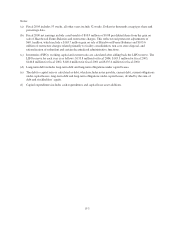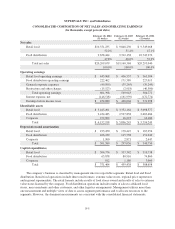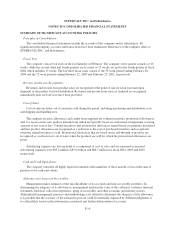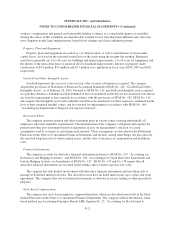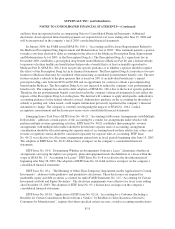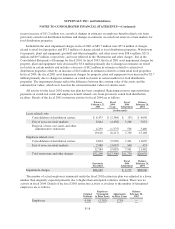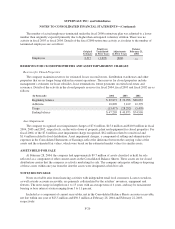Albertsons 2004 Annual Report Download - page 57
Download and view the complete annual report
Please find page 57 of the 2004 Albertsons annual report below. You can navigate through the pages in the report by either clicking on the pages listed below, or by using the keyword search tool below to find specific information within the annual report.SUPERVALU INC. and Subsidiaries
NOTES TO CONSOLIDATED FINANCIAL STATEMENTS
SUMMARY OF SIGNIFICANT ACCOUNTING POLICIES
Principles of Consolidation:
The consolidated financial statements include the accounts of the company and its subsidiaries. All
significant intercompany accounts and transactions have been eliminated. References to the company refers to
SUPERVALU INC. and Subsidiaries.
Fiscal Year:
The company’s fiscal year ends on the last Saturday in February. The company’s first quarter consists of 16
weeks, while the second, third and fourth quarters each consist of 12 weeks, except for the fourth quarter of fiscal
2004 which includes 13 weeks. The last three fiscal years consist of the 53-week period ending February 28,
2004 and the 52-week periods ending February 22, 2003 and February 23, 2002, respectively.
Revenue and Income Recognition:
Revenues and income from product sales are recognized at the point of sale for retail food and upon
shipment of the product for food distribution. Revenues and income from services rendered are recognized
immediately after such services have been provided.
Cost of Sales:
Cost of sales includes cost of inventory sold during the period, including purchasing and distribution costs
and shipping and handling fees.
The company receives allowances and credits from suppliers for volume incentives, promotional allowances
and, to a lesser extent, new product introductions which are typically based on contractual arrangements covering
a period of one year or less. Volume incentives and promotional allowances earned based on quantities purchased
and new product allowances are recognized as a reduction to the cost of purchased inventory and recognized
when the related inventory is sold. Promotional allowances that are based on the sell-through of products are
recognized as a reduction of cost of sales when the products are sold for which the promotional allowances are
given.
Advertising expenses are also included as a component of cost of sales and are expensed as incurred.
Advertising expenses were $83.4 million, $83.9 million and $86.7 million for fiscal 2004, 2003 and 2002
respectively.
Cash and Cash Equivalents:
The company considers all highly liquid investments with maturities of three months or less at the time of
purchase to be cash equivalents.
Allowances for Losses on Receivables:
Management makes estimates of the uncollectibility of its accounts and notes receivable portfolios. In
determining the adequacy of its allowances, management analyzes the value of the collateral, customer financial
statements, historical collection experience, aging of receivables and other economic and industry factors.
Although risk management practices and methodologies are utilized to determine the adequacy of the allowance,
it is possible that the accuracy of the estimation process could be materially impacted by different judgments as
to collectibility based on the information considered and further deterioration of accounts.
F-10





